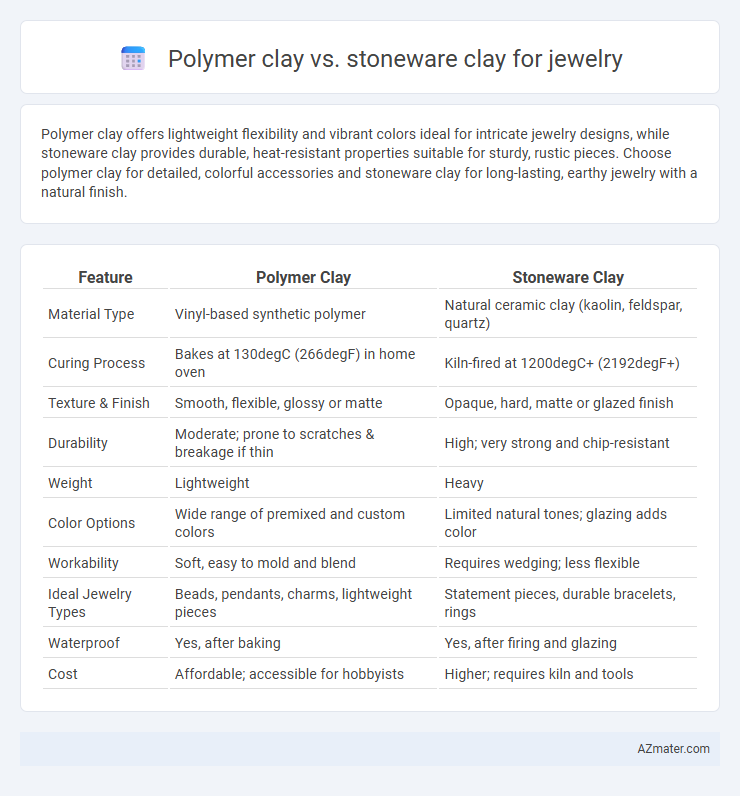Polymer clay offers lightweight flexibility and vibrant colors ideal for intricate jewelry designs, while stoneware clay provides durable, heat-resistant properties suitable for sturdy, rustic pieces. Choose polymer clay for detailed, colorful accessories and stoneware clay for long-lasting, earthy jewelry with a natural finish.
Table of Comparison
| Feature | Polymer Clay | Stoneware Clay |
|---|---|---|
| Material Type | Vinyl-based synthetic polymer | Natural ceramic clay (kaolin, feldspar, quartz) |
| Curing Process | Bakes at 130degC (266degF) in home oven | Kiln-fired at 1200degC+ (2192degF+) |
| Texture & Finish | Smooth, flexible, glossy or matte | Opaque, hard, matte or glazed finish |
| Durability | Moderate; prone to scratches & breakage if thin | High; very strong and chip-resistant |
| Weight | Lightweight | Heavy |
| Color Options | Wide range of premixed and custom colors | Limited natural tones; glazing adds color |
| Workability | Soft, easy to mold and blend | Requires wedging; less flexible |
| Ideal Jewelry Types | Beads, pendants, charms, lightweight pieces | Statement pieces, durable bracelets, rings |
| Waterproof | Yes, after baking | Yes, after firing and glazing |
| Cost | Affordable; accessible for hobbyists | Higher; requires kiln and tools |
Introduction: Polymer Clay vs Stoneware Clay for Jewelry
Polymer clay offers versatile, lightweight, and vibrant options ideal for detailed jewelry designs, while stoneware clay provides durable, high-fired strength suited for rustic and earthy styles. Polymer clay cures at low temperatures allowing easy manipulation, whereas stoneware requires kiln firing for hardness and longevity. Choosing between these materials depends on the desired texture, finish, and durability of the jewelry piece.
Material Composition and Properties
Polymer clay is a synthetic material composed primarily of polyvinyl chloride (PVC) and plasticizers, offering flexibility, lightweight properties, and ease of curing at low temperatures. Stoneware clay is a natural ceramic material made from refined clay minerals with high levels of kaolinite, fired at high temperatures to achieve durability, heat resistance, and a dense, non-porous finish. The choice between polymer and stoneware clay depends on desired texture, hardness, and firing method for jewelry applications, with polymer clay favored for intricate designs and stoneware for robust, earthy aesthetics.
Durability and Strength Comparison
Polymer clay offers moderate durability suitable for lightweight jewelry but is prone to chipping and cracking under stress. Stoneware clay, fired at high temperatures, exhibits superior strength and long-lasting durability, making it ideal for heavy-duty or intricate jewelry pieces. Stoneware's robust resistance to wear and impact significantly outperforms the more flexible yet less resilient polymer clay.
Crafting Techniques and Ease of Use
Polymer clay offers exceptional versatility and ease of use for jewelry crafting, allowing artists to shape, blend colors, and cure pieces in a home oven without high-temperature kilns. Stoneware clay requires more advanced techniques, including wedging, firing at temperatures between 1,100-1,300degC, and glazing, making it suitable for durable, professional-quality jewelry but less accessible for beginners. Polymer clay's flexibility and low skill barrier make it ideal for detailed, lightweight designs, while stoneware clay demands patience and experience to master complex pottery tools and firing processes.
Firing and Curing Requirements
Polymer clay cures at low temperatures, typically between 265degF and 275degF for 15-30 minutes, requiring an oven rather than a kiln, making it ideal for detailed and lightweight jewelry. Stoneware clay requires high-temperature firing in a kiln at temperatures ranging from 2192degF to 2372degF (1200degC to 1300degC), resulting in a durable, dense finish suitable for heavier or more robust jewelry pieces. The firing process for stoneware is more time-consuming and energy-intensive, but it produces a strong, chip-resistant jewelry component compared to the flexible and lightweight nature of polymer clay.
Design Flexibility and Color Options
Polymer clay offers exceptional design flexibility with its lightweight, pliable texture, allowing intricate details and complex shapes ideal for custom jewelry. Its extensive color palette includes vibrant hues, metallics, and marbled effects that can be easily blended or layered to create unique finishes. Stoneware clay, while more durable and suitable for functional pieces, has limited color options mostly in natural earthy tones and requires high-temperature firing, restricting immediate color customization in jewelry design.
Weight and Comfort in Jewelry
Polymer clay is lightweight and soft, making it ideal for comfortable, everyday jewelry that doesn't strain the wearer's ears or fingers. Stoneware clay, being denser and heavier, often results in jewelry pieces that feel substantial but can cause discomfort during prolonged wear. Choosing polymer clay enhances comfort with minimal weight, while stoneware clay offers durability at the expense of lighter feel in jewelry design.
Finishing and Surface Treatments
Polymer clay offers a smooth, malleable surface ideal for detailed texturing and can be cured to retain vibrant colors and glossy finishes through heat setting. Stoneware clay requires firing in a kiln to achieve a durable, stone-like surface, allowing for a variety of glazes and surface treatments that enhance tactile and visual depth. Both clays support sanding, polishing, and painting, but polymer clay excels in lightweight jewelry pieces while stoneware provides a robust, earthy finish.
Cost and Accessibility
Polymer clay offers a highly affordable option for jewelry making, with prices typically ranging from $1 to $3 per ounce and easy availability in craft stores and online. Stoneware clay tends to be more expensive, averaging $10 to $20 per pound, and may require access to specialized pottery suppliers or art studios. Polymer clay's accessibility for beginners and lack of kiln requirement make it a cost-effective choice compared to stoneware clay, which needs firing in a kiln, adding to the overall expense.
Sustainability and Environmental Impact
Polymer clay, made from synthetic materials like PVC, poses environmental concerns due to its non-biodegradable nature and reliance on fossil fuels. Stoneware clay, a natural material sourced from minerals, offers greater sustainability through its biodegradability and minimal processing impact. Choosing stoneware clay for jewelry reduces plastic waste and supports eco-friendly crafting practices.

Infographic: Polymer clay vs Stoneware clay for Jewelry
 azmater.com
azmater.com